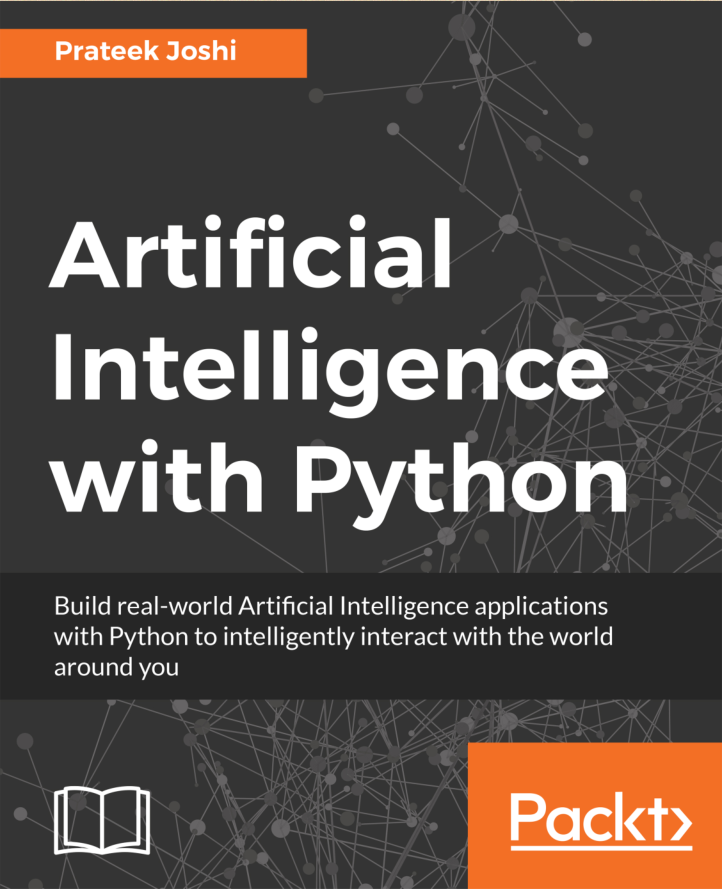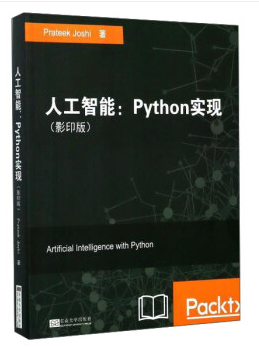《Artificial Intelligence with Python》

人工智能:Python实现(影印版 英文版)
[美] 普拉提克·乔希 著
内容简介
在现代世界中,所有一切都是由技术和数据所驱动。而人工智能与这个世界的关系正在变得愈加紧密。人工智能被广泛应用于多个领域,例如搜索引擎、图像识别、机器人学、金融等。我们会在《人工智能:Python实现(影印版 英文版)》中探索各种现实世界的真实场景,学习各种可以用于构建人工智能应用的算法。
《人工智能:Python实现(影印版 英文版)》的阅读过程中,你将学会如何就特定场景下该使用何种算法作出明智的决定。首先我们会介绍人工智能的基本知识,从中学习利用各种数据挖掘技术开发各种构建块的方法。你会看到如何实现不同的算法来得到佳的预期结果,理解如何将其应用于现实场景。如果你想为基于图像、文本、股市或其他形式数据的应用程序添加上智能层,这本激动人心的人工智能书籍绝对能够作为你的指南!
目录
Preface
Chapter 1: Introduction to Artificial Intelligence
What is Artificial Intelligence?
Why do we need to study AI?
Applications of AI
Branches of AI
Defining intelligence using Turing Test
Making machines think like humans
Building rational agents
General Problem Solver
Solving a problem with GPS
Building an intelligent agent
Types of models
Installing Python 3
Installing on Ubuntu
Installing on Mac OS X
Installing on Windows
Installing packages
Loading data
Summary
Chapter 2: Classification and Regression Using Supervised Learning
Supervised versus unsupervised learning
What is classification?
Preprocessing data
✔ Binarization
✔ Mean removal
✔ Scaling
✔ Normalization
Label encoding
Logistic Regression classifier
Naive Bayes classifier
Confusion matrix
Support Vector Machines
Classifying income data using Support Vector Machines
What is Regression?
Building a single variable regressor
Building a multivariable regressor
Estimating housing prices using a Support Vector Regressor
Summary
Chapter 3: Predictive Analytics with Ensemble Learning
What is Ensemble Learning?
Building learning models with Ensemble Learning
What are Decision Trees?
Building a Decision Tree classifier
What are Random Forests and Extremely Random Forests?
Building Random Forest and Extremely Random Forest classifiers
Estimating the confidence measure of the predictions
Dealing with class imbalance
Finding optimal training parameters using grid search
Computing relative feature importance
Predicting traffic using Extremely Random Forest regressor
Summary
Chapter 4: Detecting Patterns with Unsupervised Learning
What is unsupervised learning?
Clustering data with K-Means algorithm
Estimating the number of clusters with Mean Shift algorithm
Estimating the quality of clustering with silhouette scores
What are Gaussian Mixture Models?
Building a classifier based on Gaussian Mixture Models
Finding subgroups in stock market using Affinity Propagation model
Segmenting the market based on shopping patterns
Summary
Chapter 5: Building Recommender Systems
Creating a training pipeline
Extracting the nearest neighbors
Building a K-Nearest Neighbors classifier
Computing similarity scores
Finding similar users using collaborative filtering
Building a movie recommendation system
Summary
Chapter 6: Logic Programming
What is logic programming?
Understanding the building blocks of logic programming
Solving problems using logic programming
Installing Python packages
Matching mathematical expressions
Validating primes
Parsing a family tree
Analyzing geography
Building a puzzle solver
Summary
Chapter 7: Heuristic Search Techniques
What is heuristic search?
Uninformed versus Informed search
Constraint Satisfaction Problems
Local search techniques
Simulated Annealing
Constructing a string using greedy search
Solving a problem with constraints
Solving the region-coloring problem
Building an 8-puzzle solver
Building a maze solver
Summary
Chapter 8: Genetic Algorithms
Understanding evolutionary and genetic algorithms
Fundamental concepts in genetic algorithms
Generating a bit pattern with predefined parameters
Visualizing the evolution
Solving the symbol regression problem
Building an intelligent robot controller
Summary
Chapter 9: Building Games With Artificial Intelligence
Using search algorithms in games
Combinatorial search
Minimax algorithm
Alpha-Beta pruning
Negamax algorithm
Installing easyAI library
Ruildina a bot to olav Last Coin Standina
Building a bot to play Tic-Tac-Toe
Building two bots to play Connect FourTM against each other
Building two bots to play Hexapawn against each other
Summary
Chapter 10: Natural Language Processing
Introduction and installation of packages
Tokenizing text data
Converting words to their base forms using stemming
Converting words to their base forms using lemmatization
Dividing text data into chunks
Extracting the frequency of terms using a Bag of Words model
Building a category predictor
Constructing a gender identifier
Building a sentiment analyzer
Topic modeling using Latent Dirichlet Allocation
Summary
Chapter 11: Probabilistic Reasoning for Sequential Data
Understanding sequential data
Handling time-series data with Pandas
Slicing time-series data
Operating on time-series data
Extracting statistics from time-series data
Generating data using Hidden Markov Models
Identifying alphabet sequences with Conditional Random Fields
Stock market analysis
Summary
Chapter 12: Building A Speech Recognizer
Working with speech signals
Visualizing audio signals
Transforming audio signals to the frequency domain
Generating audio signals
Synthesizing tones to generate music
Extracting speech features
Recognizing spoken words
Summary
Chapter 13: Object Detection and Tracking
Installing OpenCV
Frame differencing
Tracking objects using colorspaces
Object tracking using background subtraction
Building an interactive object tracker using the CAMShift algorithm
Optical flow based tracking
Face detection and tracking
Using Haar cascades for object detection
Using integral images for feature extraction
Eye detection and tracking
Summary
Chapter 14: Artificial Neural Networks
Introduction to artificial neural networks
Building a neural network
Training a neural network
Building a Perceptron based classifier
Constructing a single layer neural network
Constructing a multilayer neural network
Building a vector quantizer
Analyzing sequential data using recurrent neural networks
Visualizing characters i,! an Optical Character Recognition database
Building an Optical Character Recognition engine
Summary
Chapter 15: Reinforcement Learning
Understanding the premise
Reinforcement learning versus supervised learning
Real world examples of reinforcement learning
Building blocks of reinforcement learning
Creating an environment
Building a learning agent
Summary
Chapter 16: Deep Learning with Convolutional Neural Networks
What are Convolutional Neural Networks?
Architecture of CNNs
Types of layers in a CNN
Building a perceptron-based linear regressor
Building an image classifier using a single layer neural network
Building an image classifier using a Convolutional Neural Network
Summary
Index

